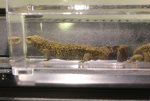firedreams
2010 Research Grant Donor
Hi all,
I recently acquired a pair of Paramesotriton from a fellow newt enthusiast, and was told that they are Fuzong Warty Newts. I have been keeping several P. chinensis for the past 5 years or so, and I must admit that these 2 newts do not look that much different. I was wondering if anyone could tell me a) if the newts in the attached pic are in fact Fuzongs and if so, b) what are the distinguishing traits?
Thanks!
I recently acquired a pair of Paramesotriton from a fellow newt enthusiast, and was told that they are Fuzong Warty Newts. I have been keeping several P. chinensis for the past 5 years or so, and I must admit that these 2 newts do not look that much different. I was wondering if anyone could tell me a) if the newts in the attached pic are in fact Fuzongs and if so, b) what are the distinguishing traits?
Thanks!


